Oh my word. I made this! And sorry its taken a week to tell you all about it. Hopefully, the stopgap offering made up for it!
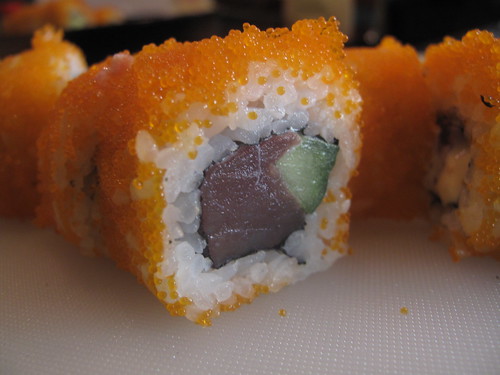
Last minute offer. First minute response.
I feel so blessed. I mean how else would you describe being wound up to high heavens and then being wonderfully compensated with an offer of a sushi class? See P’s wife, C and her friend reserved spots at a popular sushi resturant in The Hague called Kiraku (Kiraku in Japanese means ‘relax and enjoy’). At the last minute though (Thursday), her friend had to cancel and guess who got offered the spot? Well….yes…..me!
P came into the office and asked me if I liked sushi. Of course I like sushi – fashionable as it is. But did I know what good sushi was? Hmmm, not really. I wouldn’t exactly rate my store-bought rice rolls for bespoke, made-to-order authentic Japanese sushi! To be honest, I’d always somewhere deep inside me wanted to learn to make sushi but you know when you think things are kind of further down the line to be done? That was sushi for me. I knew I’d get to it someday in the future and the future came quick!
So see why I feel that I’m blessed? As for P, he has more than redeemed his image….till he trips me up again at least. By Friday it was confirmed that I would go and the rest is history. Save for the bit when I had to rush out the door, face and mouth stuffed with delish choccie waffles…into grey skies and rain drops.
Late trams and many stops later, I arrived at the resturant, a few minutes after 12.

Everything was laid out and there were about 8 other people, each with their own place setting complete with knife, waterbowl and sushi mat.
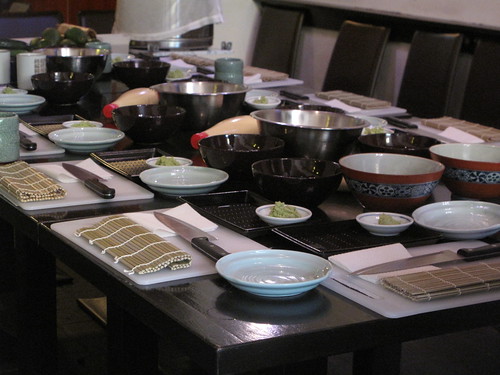
The resturant is quite nice….in front you have the sushi bar, in the centre of the ‘room’, we had our class. Since that was my first time there, I have no idea how that part normally looks. And at the back, there is a little ‘tatami section’…very romantic!
To break the ice, we all had cups of green tea while we waited for 1 more person to turn up (if my Dutch served me well)! See this is a Japanese resturant in the very Dutch city of the Hague and while I speak some Dutch, sometimes I have to reason some things out by snatching a few familiar words and then joining the dots! A few minutes later, we began.
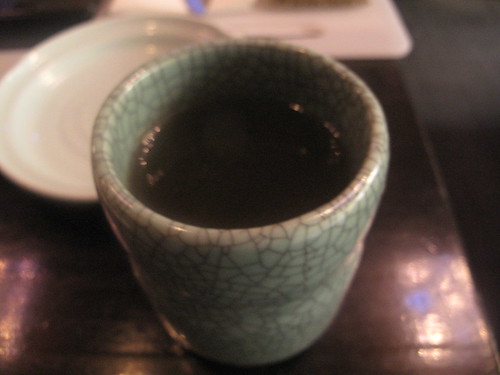
We started by prepping the fish and then making the sushi. When we were done with rolling and cutting…we were then shown how to make the sushi rice. However, I think its best if I start with the sushi rice and go from there….so we get the ‘train’ right.
Some things I learned
- There is vegetarian sushi and it tastes pretty good. You can choose from a variety of egg, avocado, cucumbers…to name a few
- I know what sashimi is
- I can recognise inside out sushi…anywhere
- I enjoyed the salmon sashimi – to my utmost suprise seeing as smoked salmon is up there with celery (or down there shall I say)
- There is symmetry in sushi making
- Oh and I learnt how to make sushi.
Now the class was in Dutch but the photos are in English 🙂 Aren’t you thankful? And about the videos, hmmm just watch them ok, if you understand Dutch then by all means listen!
Sushi preparation :
1. Begins with the rice
Sushi rice is essentially short-grain, sticky rice. Before it is cooked, it is gently washed in water
till it runs clear.
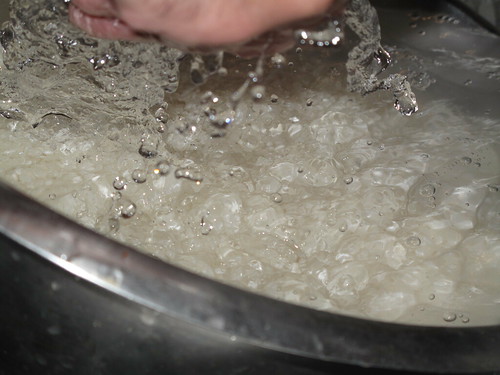
To cook the rice, a general measure of 1 cup of rice to 1 + cup of water is used and it is cooked for 20-30 minutes, without seasoning.
Once the rice is cooked it is seasoned and is ready for use
2a. Prep the other ingredients : Fish (if using) or…
Day fresh salmon: a huge one cost the resturant guys about 11 euros!!!!!!!!!!!! Dirt cheap. They buy wholesale from the ‘grootvishandel’ (Fish wholesalers). If I had to buy this at my local, I’d be looking at something close to 50 euros I’m sure.
Now the fish was fresh, smelt of the sea and its eyes were open. You could tell it was at its prime. And once I tasted it, I abandoned all reservations about ‘raw food’! It was amazing. Tender with a light, delicate flavour. Way to go!
After the salmon was split open and filleted, the sushi chef trimmed away bits. There are many parts of the salmon which aren’t sushi-grade like the obvious head and tail but edges were trimmed off as well and all these went into a bucket – useful for the stock pot I guess! The next step was removing the centre bones with a tweezer and then slicing down each fillet in half. Once that was done, he cut each half fillet into halves along the length and then took off the skin! Finally, using his fingers as a ruler, he measure out salmon chunks for each of us round the table
2b. …. vegetables.
In our case we used avocados and cucumbers and men….is symmetry important. Not that my own cuts showed that….
…. but watch the chef 🙂
Note: The variety of sushi out there is astounding. Each variety is named after the look/technique. We made
- Maki-sushi – rice and other additions, rolled in seaweed.
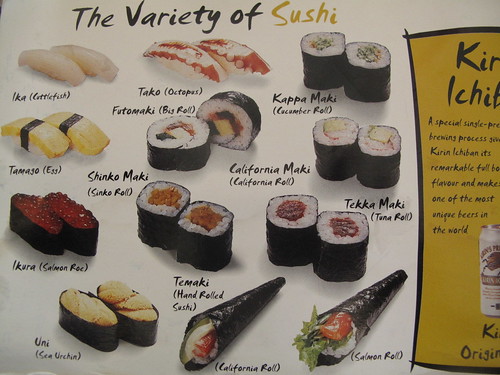
- Nigiri-sushi – fish topped rice pads, slices of fish or other items on pads of rice
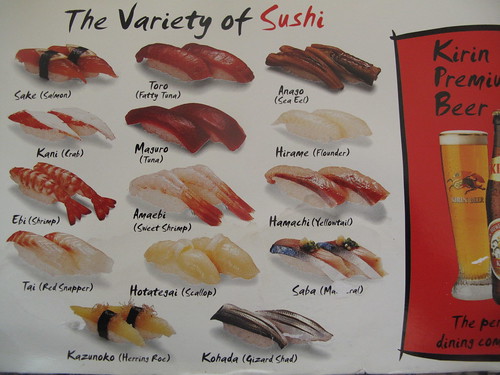
- Sashimi – Fish slices, served with regular boiled rice on the side
and
- California roll aka inside out sushi or sushi inside out!
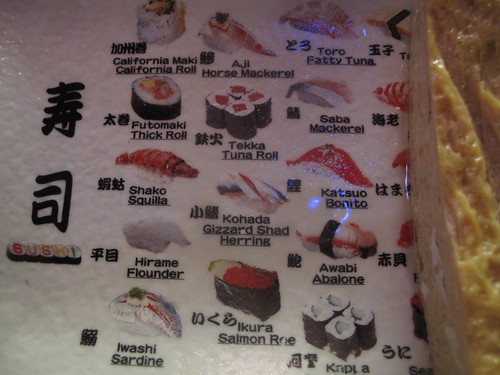
3. The penultimate step – assembly
Your sushi mat should be in front of you with the tied ends at the top!
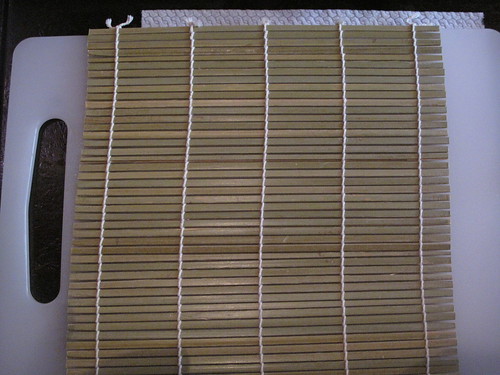
Now every sushi mat has two sides – a rounded side and a flat side.
You lay the mat rounded-side down, with the flat, smoothish side facing up. Take a sheet of Nori (Japanese seaweed). This also has two sides: a smooth shiny side and a duller textured side (if memory serves me well).
To make Maki-sushi
This sheet is gently folded in two halves and gently broken to split
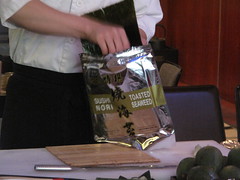
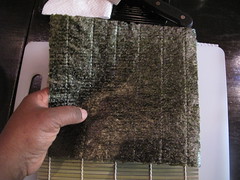
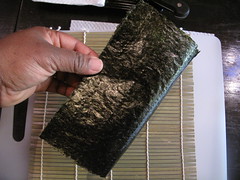
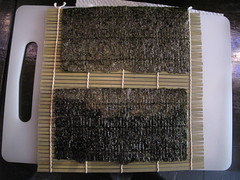
Then a ball of rice is rolled up. The chef put his ball at one end and worked the rice out till it was well spread. I could do no such thing (at least not in this first class!). So, I put my rice in a central ridge. Then it is spread it out till flat, leaving a no-rice border all the way round.
The rice is worked….such that you erect a mini wall round the rice centre spread.
Some wasabi paste is spread in the centre of the rice and 2 slices of ‘cucumber’ , avocado or fried egg are placed on the wasabi-flavoured rice centre. It is best to place your nori half at the end of the sushi mat closest to you to save moving it about when it is time to roll it!
And then you start rolling!
And your sushi roll is ready. We’ll talk about cutting it later
To make The California Roll: This was by far the most exciting sushi roll I made 🙂
I’d never really paid attention to inside-out sushi, never been aware of its existence. I must have seen it before but it never really registered. Apparently, this ‘inverted’ sushi was born in the ‘ 60s, in LA (Los Angeles). There were many Japanese sushi chefs seeking their fortunes in the States. At The Tokyo Kaikan restaurant (one of the first sushi bars in LA), Ichiro Mashita, a sushi chef began substituting avocado for tuna (toro) because he felt the oily texture of the avocado was a perfect replacement. Many trials down the road, the California roll was born. Now traditional sushi rolls are wrapped with nori on the outside. Eventually, Mashita made the roll “inside-out”, i.e. uramaki, because Americans did not like seeing and chewing the nori on the outside of the roll! Did I mention the addition of Mayonnaise…… Hmmmm!
So this time, rather than leave a border round your halved nori sheet (don’t forget to place it at one end of your sheet), you fill it entirely with rice. Then in our case, rich folk that we are :-), we spread caviar liberally on the rice. Next, place a piece of clingfilm (or another sushi mat) over the nori-rice-caviar stack and fold the other half of your sushi mat over. Then flip the mat over…so when you open it up, the nori is now on to! Grab your bottle of Japanese mayo and spread it down the centre of your nori sheet. Next place 2 slices of avocado and salmon (or tuna) and then the roll begins…. In the end, you’ll have a nice long roll, ready to be cut1
To make Nigiri-sushi
Take a piece of salmon or Tuna. Smear it with some wasabi paste and place a rice ball on it. Next, press the rice out using your fingers, till a ‘rice pad’ is formed (and rectangular). Then flip the fish slice – rice construction into your other hand, leaving it wedged between your thumb and forefinger. Next step is to place it fish-side up back in your original hand. Curl your finger around it and press sides. Nigiri-sushi is ready!
Halfway through the class, we got served some super tasty Miso soup
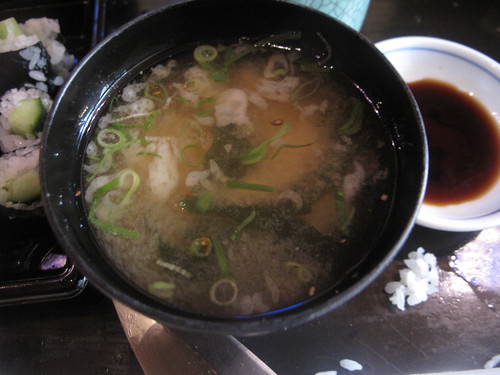

And then got back to work.
To make Sashimi
Now I’ve left how to cut the sushi ’cause that deserves a spot of its own.
Once the rolls are ready, the knife is made wet by dipping it in a bowl of water. Then it is raised up and the water is left to roll down the blade. Next, cut each roll in half (symmetry is very important), and then cut each half into quarters. Now the way the knife is moved is actually counter-intuitive (to me!) You rock the knife back and forth while applying pressure to cut it. If you attempt to cut it in one fell swoop by pressing the knife down once, you end up with the insides being pushed out so… the rocking motion works best to cut the sushi and give it a clean edge!
And that’s it…your sushi rolls are ready. To be eaten. Properly. But I think I failed on that count….my rice got wet and discoloured in the soy sauce…..but boy did it taste good. I also dipped it in the wasabi…living on the dangerous side (where food is concerned) is very much my style, though trying Fugu (blowfish) will not be attempted, I assure you!
The beauty of the class was everyone arranged their pieces in the box how they wanted – while of course munching away! This is how C’s box looked…
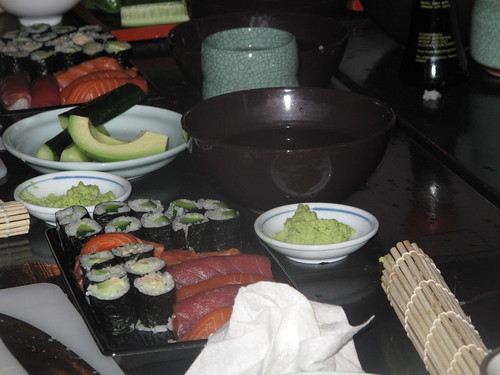
….and mine!

And when all was set, we put lids over them…but not before adding slices of fiery hot and sweet ginger pickles and wasabi!
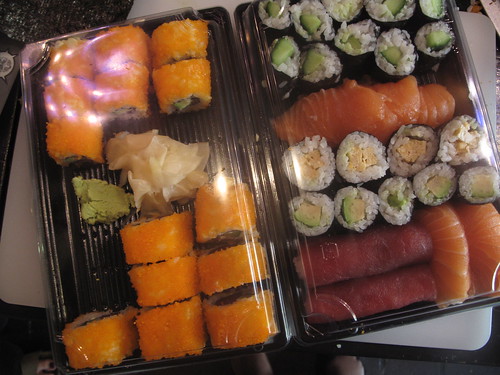
Note that sushi is best eaten on the day it is made…not because the food is raw (the wasabi and sushi vinegar in the rice….work as antiseptics almost) but because after a day in the fridge, the fish juices begin to ooze into the rice, affecting the fresh, clean taste!
According to Wikipedia
‘Sushi’ literally means ‘it’s sour’. The science behind the fermentation of fish packed in rice is that the vinegar produced from fermenting rice breaks the fish down into amino acids. This results in one of the five basic tastes, called umami in Japanese. The oldest form of sushi in Japan, Narezushi still very closely resembles this process. In Japan, Narezushi evolved into Oshizushi and ultimately Edomae nigirizushi, which is what the world today knows as “sushi.”
Contemporary Japanese sushi has little resemblance to the traditional lacto-fermented rice dish. Originally, when the fermented fish was taken out of the rice, only the fish was consumed and the fermented rice was discarded. The strong-tasting and -smelling funazushi, a kind of narezushi made near Lake Biwa in Japan, resembles the traditional fermented dish. Beginning in the Muromachi period (AD 1336–1573) of Japan, vinegar was added to the mixture for better taste and preservation. The vinegar accentuated the rice’s sourness, and was known to increase its life span, allowing the fermentation process to be shortened and eventually abandoned. In the following centuries, sushi in Osaka evolved into oshi-zushi. The seafood and rice were pressed using wooden (usually bamboo) molds. By the mid 18th century, this form of sushi had reached Edo (contemporary Tokyo).
The contemporary version, internationally known as “sushi,” was invented by Hanaya Yohei (華屋与兵衛; 1799–1858) at the end of Edo period in Edo. The sushi invented by Hanaya was an early form of fast food that was not fermented (therefore prepared quickly) and could be eaten with one’s hands roadside or in a theatre.Originally, this sushi was known as Edomae zushi, because it used freshly caught fish in the Edo-mae (Edo Bay or Tokyo Bay). Though the fish used in modern sushi no longer usually comes from Tokyo Bay, it is still formally known as Edomae nigirizushi.
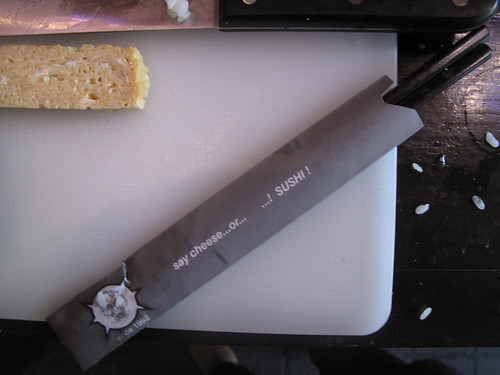
A day to remember…..and one to re-enact. Oh, you can bet I’ll be experimenting with sushi soon. I have some black sesame seeds, which I think will look great on ‘California rolls’…and I’m longing for the delicious avocado sushi! Yum. Till then, I’ll say …..SUSHI!
Are you a sushi fan? Do you think its too risque? Tell us all….and share your weetjes (bits of knowledge) please!



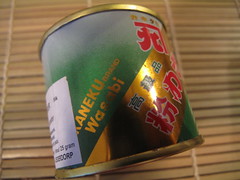
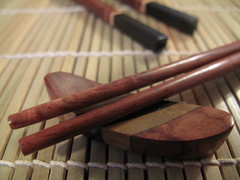

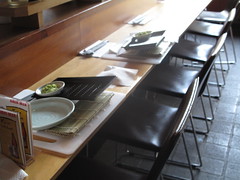
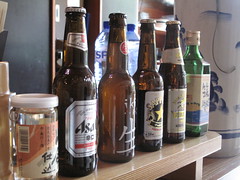

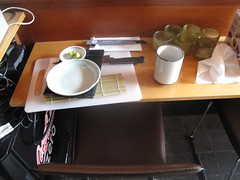
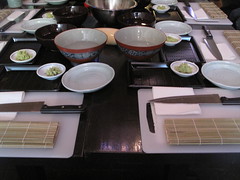

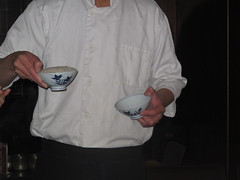


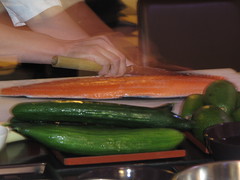
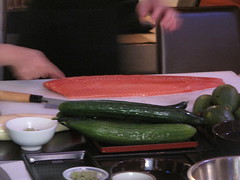
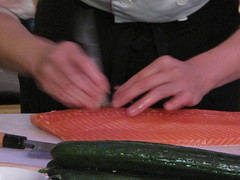
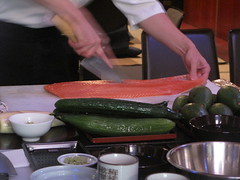
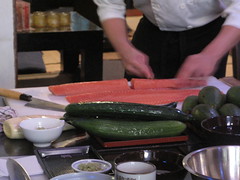
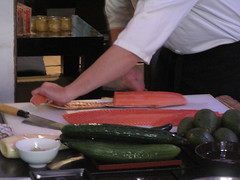
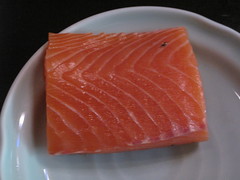
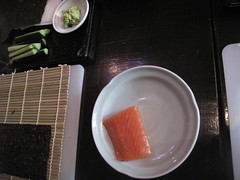
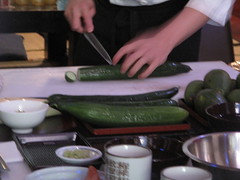
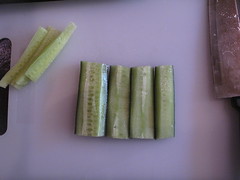
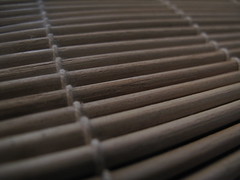
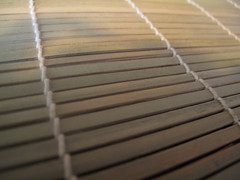
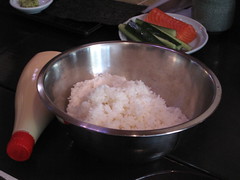
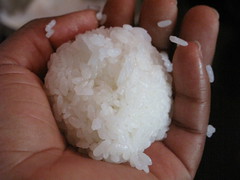
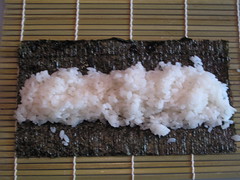
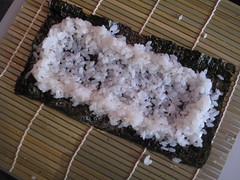
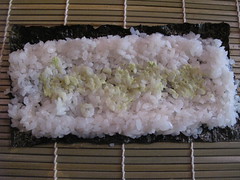
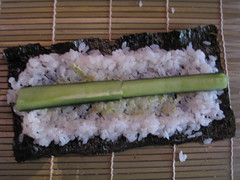
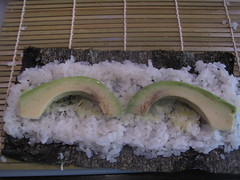
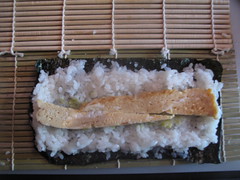
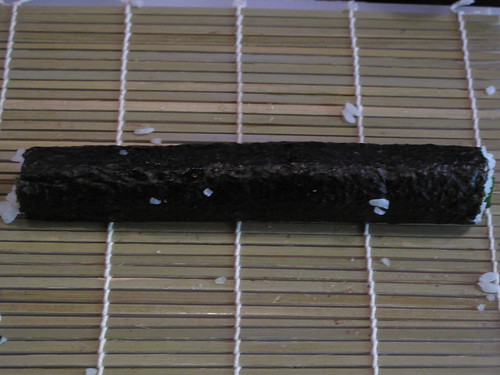
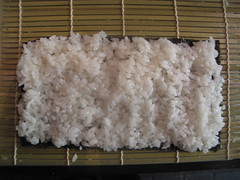
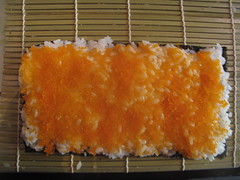
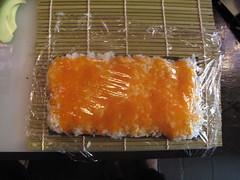
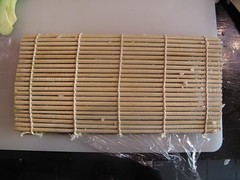

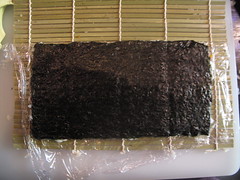
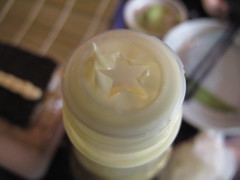

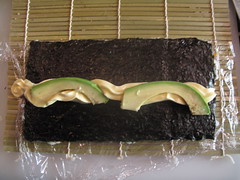
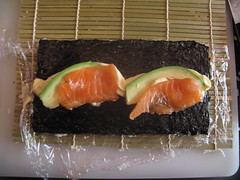
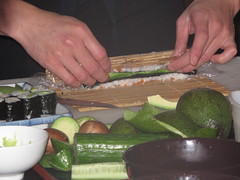
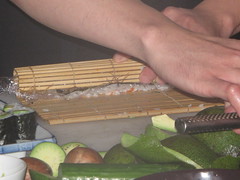
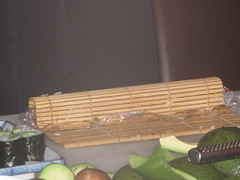
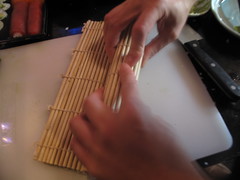
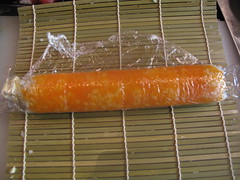
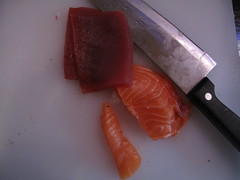
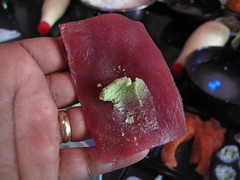
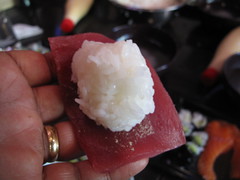
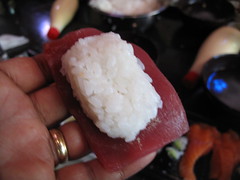
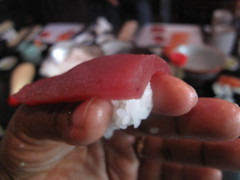
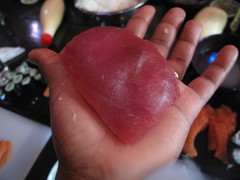
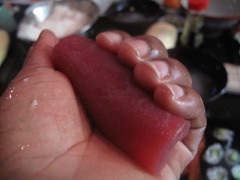
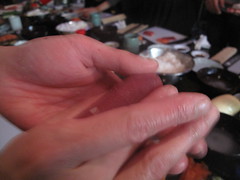
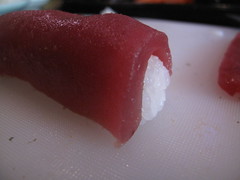
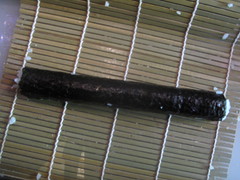
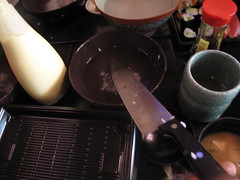
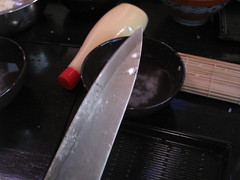
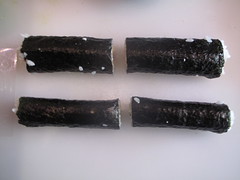
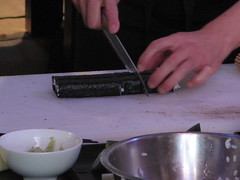
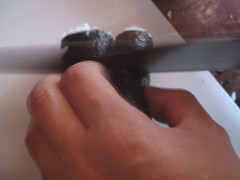
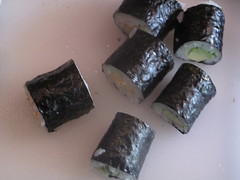
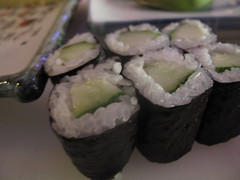
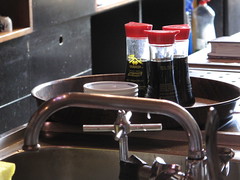
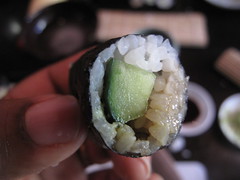
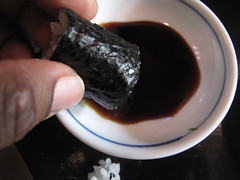
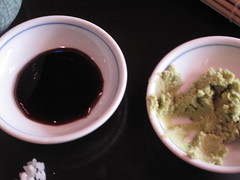
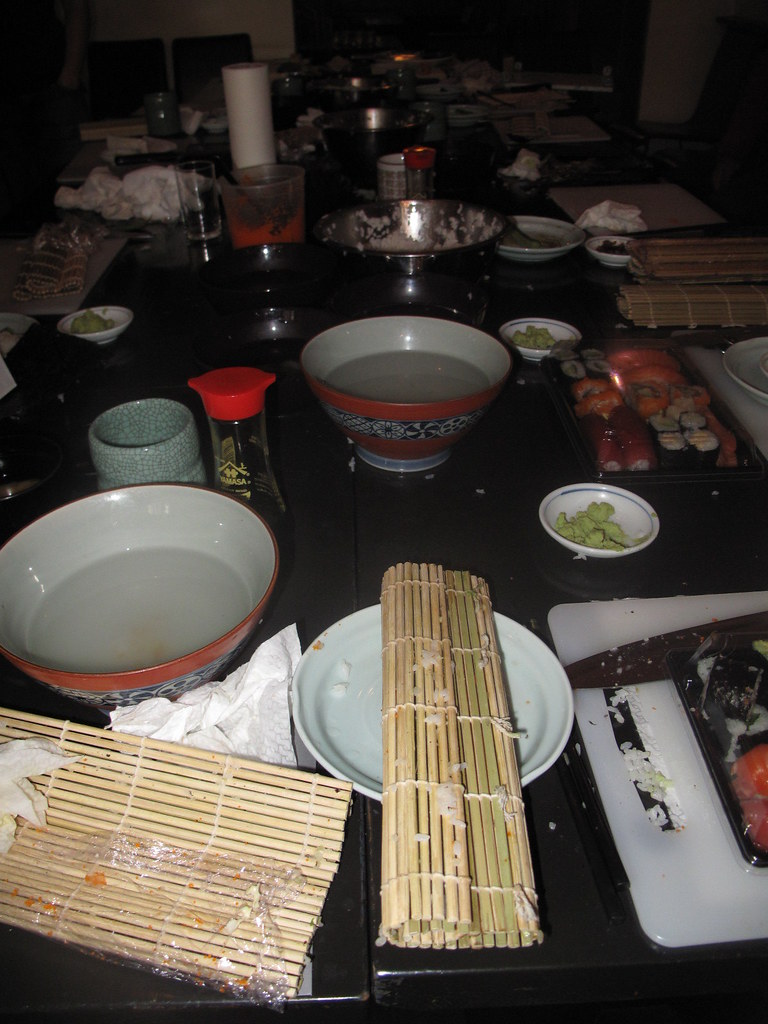
Leave a Reply